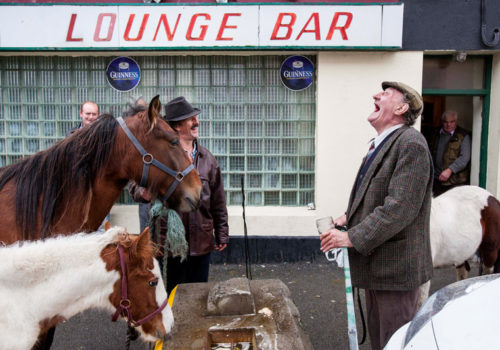When Irish-born photographer James Horan was growing up in a housing commission estate in Limerick he was warned to keep away from the ‘travellers’ as the Irish gypsies are known. “Crazy, dangerous people, that you didn’t want to associate with,” he says.
The Travelers are a group of nomadic peoples who have lived in Ireland for centuries and while they are not associated with the Roma gypsies there are similarities in as much as they live and marry within their own ethnic group.
In Ireland in recent times there have been moves by the government to settle the gypsies into communities with mixed results. Horan tells me the Travelers have always had a bad reputation. “They keep horses as pets and many consider them undesirables,” he says from his studio in Sydney where he now lives. “It wasn’t until I moved to Australia and had a girlfriend who was into dressage that I even thought about them again, but her interest sparked mine. I realised I didn’t have any photographs to back up my stories, and that’s where the idea for this photo essay came from”.
The Travelers negative reputation has been exacerbated by the fact that the media in Ireland has focused on issues around cruelty to animals. “That wasn’t my objective,” says Horan although he doesn’t deny that there have been problems. “Rather I wanted to take a documentary approach to a part of Irish culture that is in danger of disappearing”.
Back in Ireland Horan had a loose idea to photograph the gypsies of his youth, but what he didn’t expect to discover was that many “are decent human beings with interesting stories like the rest of us. I made friends with a lot of them and found them to be lovely, fabulous people. I was ashamed I had discriminated, it had been snobbery on my part”.
Over a period of five years Horan integrated himself into the Travelers community, not an easy task given they were initially suspicious of him, but as he earned their trust he began to discover a world he knew nothing about.
“I went back to Ireland where I grew up and I found these kids. They didn’t trust me at first, thought I was a newspaper photographer and I had to convince them I knew people in the area, that I had family there. They began to relax with me and eventually showed me one of their homemade stables where they kept their pets, their horses. I shared prints of the photographs I’d taken with these people and they were delighted and their friends wanted photographs – they’re very proud of their horses. So the project grew very organically and I met more people with horses who told me about the rural horse fairs, that I never knew existed.”
Horan travelled the countryside visiting these rural horse fairs where congregations of Travelers would gather to tell stories, and buy and sell horses in a tradition that has existed for centuries. On one of these trips he learned about the Smithfield Market in Dublin, a market that had been held monthly since the 17th Century.
He tells that the Smithfield Fair attracts Travelers as well as the city’s underprivileged kids, two groups that the newly gentrified area’s residents were keen to move on. “The residents kicked up and they shut the market down and now it’s only on twice a year,” says Horan. “A lot of Irish people would rather not see these kids with the gypsies’ horses because they are associated with animal abuse. But the flip side of that is that they need to be taught proper horse husbandry. There was meant to be grants given to train them and then the recession hit and that went out the window”.
It is clear in the tone of Horan’s voice that he feels deeply about the plight of his homeland’s gypsies. Although he is not blind to the problems that have created a public backlash, perhaps by telling their stories he can create a greater understanding before the Irish Gypsies are lost to the annals of history.
EXHIBITION
Irish Horse
by James Horan
Part of Head On Photo Festival
Until 14 June
Brenda May Gallery
2 Danks Street
Waterloo
Australia
















